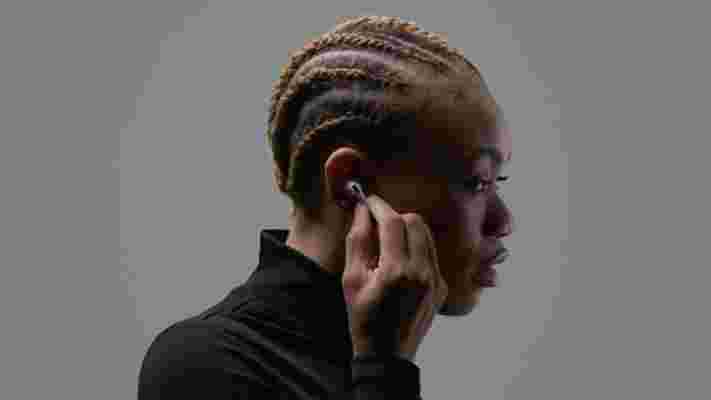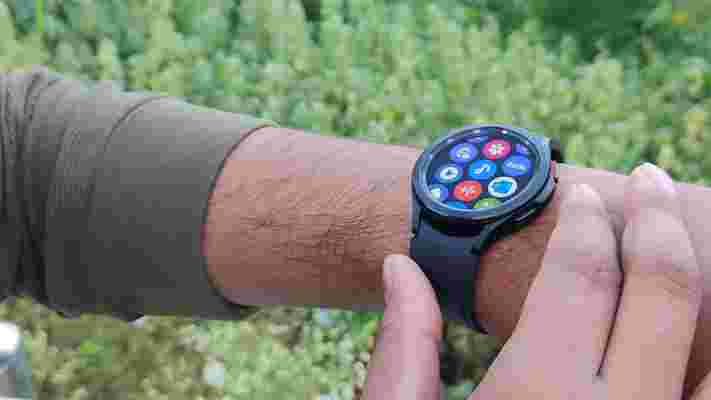The Apple AirPods Pro 2 are the likely next-generation of the company’s popular noise-cancelling earbuds – and if the rumors are to be believed, they’ll be the most advanced true wireless earbuds we’ve ever seen.
The original AirPods Pro are among the best wireless earbuds you can buy, with immersive Spatial Audio support, active noise cancellation, and fantastic integration with the wider Apple ecosystem.
The next version of these buds are rumored to come with a range of significant upgrades: We’ve heard about everything from codewords that can control the active noise cancellation to blood oxygen monitors embedded in the earbuds themselves. But how likely are such futuristic features?
Since the AirPods Pro 2 are expected to launch later this year (according to respected analysts like Ming-Chi Kuo ), perhaps the more fanciful ideas are just too futuristic - so let’s analyze the intriguing features we’ve heard about so far.
Noise cancellation codewords

The most recent rumor circulating about the AirPods Pro 2 is that they’ll allow specific codewords and voices to ‘break through’ their active noise cancellation settings.
Spotted by Apple Insider , a new patent application called ‘ Interrupt for noise-cancelling audio devices ’ describes a new feature that’s designed to stop you from missing out on important conversations while active noise cancellation is switched on.
As explained in the patent, a user “may desire to be interrupted by pre-designation contacts… or by a person who speaks a designated keyword to the user”.
So, if your partner is shouting your name to say that dinner’s ready, future AirPods could turn off the active noise cancellation, enter Transparency mode, or turn off your music to allow you to hear them.
To stop any person from interrupting your music, you’d be able to pre-approve contacts known to you and your devices – and to determine whether you’re the one being addressed by these contacts, the AirPods could analyse the volume of their voice and how long it takes for their voice to reach you.
The patent also describes how this could work with codewords as well as voices, so you could train your AirPods to recognize when any person says your name, and turn off your noise cancellation accordingly.
How likely is this to happen? As with any patent, there’s no guarantee that the technology described here will actually make an appearance, let alone in a new version of the AirPods Pro that’s expected to launch in a few months.
This feature would be useful, and it certainly isn’t outside the realms of possibility that your iPhone could identify different voices and switch off your AirPods’ noise cancellation.
After all, Siri can recognize up to six different voices on the Apple HomePod and HomePod mini , and tailor its responses accordingly.
The technology required to make this feature work is definitely present – but whether it would be available at the time of the AirPods Pro 2 launch is another question. Apple has previously updated accessibility features on its AirPods range of products well after their launch dates, and we could see something similar happening here, perhaps to coincide with a new version of iOS .
Blood oxygen monitoring

The rumor that future AirPods will be able to monitor your blood oxygen levels is something we’ve been hearing about for some time now.
A 2020 leak from LeaksApplePro claimed that the AirPods Pro 2 will specifically come with ambient light sensors, backing up a previous report by DigiTimes that said future AirPods will use ambient light sensors to take biometric measurements – potentially for monitoring blood oxygen levels, as seen in the Apple Watch 6.
This could work like the ear-based clip-on pulse oximeters used in hospitals, which shine light through the earlobe to detect the level of oxygen in a patient’s bloodstream.
This would allow the AirPods Pro 2 to collect fitness data and measure it over time – useful, if you’re using the earbuds as running headphones – and perhaps even monitor conditions that cause shortness of breath and low oxygen levels.
How likely is this to happen? We don’t think this one is very likely. The current AirPods Pro don’t rest on the earlobe in a way that would work for a blood oximeter, and integrating an actual ear clip would bring a drastic design change to the AirPods Pro. Of all the earbuds that this feature could come to, the Powerbeats Pro are more likely, since they hook around the ear and have more contact with the skin.
Saying that, the technology to do this does exist. In 2019, FreeWavs completed a successful crowdfunding campaign for a pair of fitness earbuds that can measure your blood oxygen levels, as well as other biometric data. However, the product never came to market, with the company citing issues with accurately detecting blood oxygen levels, and even contemplating releasing a version of the earbuds without this feature to appease its backers.
Apple is a much larger company though, and if any brand could make this feature work, it’s Apple. We’ve already seen Apple integrate a pulse oximeter into the Apple Watch 6 , which offers the ability to measure blood oxygen levels. As Apple says, measurements taken with the Blood Oxygen app on the Apple Watch 6 are “not intended for medical use and are only designed for general fitness and wellness purposes”, which makes it ripe for fitness-focused headphones.
Gesture controls

Like all of the futuristic AirPods Pro 2 features we’ve heard about, gesture controls is a rumor borne out of patents awarded to Apple.
The first was a 2020 patent that describes the ability to control a pair of true wireless earbuds with ‘in-air’ gestures – for example, hovering a hand over the AirPods to turn off the noise cancellation or pause your music. This feature would use capacitive sensors to detect the proximity of the user to the AirPods.
More recently , Apple filed a patent for even more ‘out there’ gestures, describing earbuds that could be controlled by touching your face, shaking your head, and clicking your teeth together. These actions wouldn’t even be limited to the user’s own body, with the ability to control the earbuds by touching another object – for instance, tapping a table or squeezing the arm of another person.
How likely is this to happen? Cupping an ear over your earbuds to pause active noise cancellation or your music doesn’t seem that far fetched, and we can see Apple implementing this with a next-gen pair of AirPods Pro.
However, we can’t see people using the more flamboyant gestures in public, and it would be very difficult for Apple to ensure these gestures are accurately picked up by the earbuds. We’ve seen gesture controls implemented in true wireless earbuds such as the TicPods 2 Pro , which allow you to accept calls by nodding your head, and reject them by shaking it. However, we have found that such controls rarely work well, if at all.
It’s rare for Apple to take these kinds of risks with its products, preferring to let other companies experiment with new technologies before implementing them itself. Apple products are known for working well and for delivering ease of use, and the company is unlikely to take a gamble on gesture controls if it isn’t confident that they’ll work every time.
What’s likely to actually change in the AirPods Pro 2?
The rumored features that are most likely to come with the AirPods Pro 2 are less headline-grabbing than blood oxygen monitors and codewords, but they’re interesting all the same.
We can expect some improvements to the active noise cancellation technology; the AirPods Pro were released in 2019 and the technology has moved on since then, with models such as the Bose QuietComfort Earbuds offering near-silence with the ANC feature switched on. While Apple’s noise-cancelling earbuds do block out a good amount of ambient sound (especially if its a constant sound, like a rumbling train), you’re still able to hear things like music playing in a shared office.
We’re also hoping to see some improvements to the audio performance of the AirPods Pro, and we’d love for Apple to include an adjustable EQ so users could tweak the sound to their liking. This would let you dig into the different frequency bands - perhaps boosting the bass when you’re exercising to power you through your workout, or increasing the trebles and mids so voices sound clearer on podcasts .
Support for lossless audio and hi-res streaming is a possibility, too, as Becky Roberts, Hi-Fi and Audio Editor for What Hi-Fi? explains: “The AirPods 2 will likely be the first Apple headphones to launch since Apple Music went lossless and hi-res, and Apple will no doubt be keen for its headphone hardware and music software to be on the same page for audio quality, as is the case with its spatial audio technology.”
It’s not as simple as including support for a hi-res audio codec though. “The barrier to truly lossless support for headphones like the AirPods that rely solely on Bluetooth connection (i cannot be wired) lies in whether Apple can raise the ceiling of Bluetooth transmission quality, or find an alternative method to send high-quality music wirelessly to headphones.”
“We may be looking at an AirPods model further down the line for that,” she says. In any case, it’s clearly an issue that Apple is looking into. In an interview with What Hi-Fi? , Apple's VP of Acoustics, Gary Geaves said that “there’s a number of tricks we can play to maximise or get around some of the limits of Bluetooth,” but that “it’s fair to say that we would like more bandwidth”.
Truly lossless streaming, that doesn’t heavily compress audio files and reduce the detail in your music could be made possible with Qualcomm’s aptX Lossless codec , which can deliver CD-quality streams over Bluetooth, and is expected to start coming to headphones later this year.
Without the need to squeeze all the detail out of your music so that the files can be transmitted wirelessly, this codec should deliver a sound that closely replicates the quality that the musicians and engineers were working with in the studio at the time of recording.
Whether this technology will come to the AirPods Pro 2 remains to be seen - and as Roberts said, we still might not get fully lossless AirPods in 2022.
It’s also possible that the AirPods Pro will see a dramatic redesign in 2022, with Apple getting rid of the protruding ear stems that make its AirPods earbuds so instantly recognizable.
Of course, there’s no guarantee that any of these rumors will be proven right, or that the AirPods Pro 2 will even be released in 2022. Apple hasn’t confirmed that it’s working on the next generation of its noise-cancelling earbuds , and is very unlikely to do so before an official launch
Still, we’re pretty confident that the company will upgrade the AirPods Pro before the year is out. Three years after their release, the AirPods Pro are still a good pair of true wireless earbuds, but they certainly aren’t the best you can buy. Apple will want to change that by releasing a pair of earbuds that can compete with class-leading models from big competitors such as Sony, Bose and Sennheiser - and by focusing on more futuristic features, it could detract from areas it’s less adept in, like audio quality and noise cancellation.
Saying that, we daresay Apple will stay true to form and work on perfecting the less headline-grabbing features of the AirPods Pro before taking a risk on emerging technologies like biometric sensors, voice recognition, and gesture controls.
Succession season 4: everything we know
Succession season 4 is officially on the way – and by the sounds of things, fans won't have too long to wait for the return of television’s most dysfunctional family.
Showrunner Jesse Armstrong’s fictionalized take on the Murdoch media empire is dark, dramatic and often hilarious – combining tension and comedy in ways rarely seen on screen – and season 3 continued to prove why it’s one of the best HBO Max shows around.
Having developed something of a cult following in recent years (1.7 million people caught its most recent season finale), it’s no wonder Succession has already been green-lit by HBO for a fourth outing, and we’re excited to see how future episodes intend to tie up the loose ends left by season 3’s explosive cliffhanger.
Below, you’ll find everything we know about Succession season 4 so far – from details on returning cast members to its likely release date and potential plot threads.
Naturally, spoilers follow for Succession seasons 1-3 , so proceed with caution.
Release date: No official release date has been shared by HBO just yet, but we anticipate Succession season 4 to arrive either late 2022 or early 2023. Leading man Brian Cox alluded to a June 2022 filming schedule back in October 2021, while showrunner Jesse Armstrong confirmed, in May, that season 4's script is "almost done."
Cast: Given that HBO has renewed the show for a fourth season, we’re anticipating returns for all the major Roy family cast members, along with the actors playing fringe characters like Gerri, Willa, Stewy and Ewan. We also expect Alexander Skarsgård to reprise his role as Lukas Matsson. Adrien Brody’s future as Josh Aaronson is less clear, though.
Story: After Logan’s shocking decision to consider Matsson’s offer of buying Waystar Royco, we expect Kendall, Shiv and Roman to band together in an effort to relieve power from their father in season 4. Shiv and Tom’s marriage is also likely to come under the microscope, following the latter’s presumed betrayal.
Given that Succession’s third season didn’t conclude until December 2021, we’re not anticipating season 4 to arrive any time soon. We do know it’s coming, though, after HBO Executive Vice President, Francesca Orsi, confirmed the renewal of the Emmy Award-winning show in a 2021 press release .
Judging by the time it takes to film each season – and knowing that shooting on new episodes isn’t yet underway – the earliest we expect Succession season 4 to arrive is late 2022, between October and December.
That would mark a decidedly shorter seasonal gap than the one between seasons 3 and 4, mind. Amid the pandemic-induced chaos of 2020, WarnerMedia shut down production on all of its series, including Succession, which pushed season 3’s expected 2020 release date back by more than a year to October 2021.

Seasons 1 and 2 landed in the summers of 2018 and 2019, respectively, but it wouldn’t be unreasonable to assume that future seasons will adopt an annual release schedule later in the year, with Covid-19 having pushed season 3’s arrival to October.
In a 2021 interview with GQ , leading man Brian Cox revealed that the show’s producers plan to start filming Succession season 4 in June 2022, as long as writing gets underway as early as January.
"That's roughly the plan. I think the writers are getting back in January,” he said. “I was surprised because I thought they'd be getting back in November. But I do think they need a break. I mean, I think that they do need space, because they've been working really hard on [the show]."
More recently, the show's creator, Jesse Armstrong, revealed to reporters in May that the writing process on Succession season 4 is almost complete . “We’re almost done with the writing for season 4, here in London, with the American writers coming over,” he said at the BAFTA TV awards, adding that he’ll soon be sharing the script with the series’ cast for feedback, because “it’s useful, they’re smart and they think things about their character[s].”
As usual, we expect Succession season 4 to arrive on HBO Max in the US and Sky Atlantic in the UK. Depending on its release date, European viewers may be able to enjoy Succession, too, thanks to the planned rollout of HBO Max across the continent later in the year.
As for which cast members we expect to return for Succession season 4, it’d be a huge shock if Brian Cox, Jeremy Strong, Sarah Snook, Kieran Culkin, Alan Ruck, Matthew MacFadyen or Nicholas Braun didn’t all reprise their roles.
After all, Succession’s drama is wholly reliant on examining the twisted relationships between the characters in its central Roy family (the clue is in the show’s name). Future episodes would struggle to maintain the series’ compelling tensions should even one member exit the fray.

As such, we expect all of the Roys to return for season 4. Judging by comments made by various cast members (which you’ll find further down this article) about their excitement for future episodes, it seems that many key actors have already confirmed their involvement.
We also anticipate that fringe characters like Gerri (J. Smith-Cameron), Willa (Justine Lupe), Stewy (Arian Moayed) and Ewan (James Cromwell) will return for season 4.
Although many of these characters don’t play a direct role in influencing the question at the heart of the show – who will inherit Logan Roy’s media empire? – almost all maintain very particular relationships with certain Roy family members that reveal more about the motivations of the show’s main players; they’re therefore important pieces of Succession’s puzzle.
The same goes for Alexander Skarsgård’s tech entrepreneur Lukas Matsson. At the end of season 3, Logan Roy – in a move that shocked his children – appeared to strike a deal with Matsson to relinquish power of Waystar Royco in exchange for a payout.
Given that this decision is likely to form the crux of season 4’s plot, it’s safe to assume that Skarsgård will be returning to Succession for future episodes.

Less clear is whether Adrien Brody, who briefly starred in season 3 as billionaire investor Josh Aaronson, will reprise his role. Aaronson was used as a vessel through which Succession’s showrunners sought to question Logan’s competence as an elderly CEO. Having fulfilled that purpose, it’s hard to see where Brody could take the character next.
Still, even if Brody doesn’t return as Aaronson, we wouldn’t be surprised to see more A-listers step into Succession’s boardrooms as new characters in season 4.
Following the fallout of Kendall’s betrayal and Logan’s gung-ho quest for revenge in Succession season 2, last year’s episodes placed the spotlight on each Roy sibling equally, giving actors Jeremy Strong, Sarah Snook and Kieran Culkin room to flex their (at times cringe-inducing) muscles.
Season 4 seems primed to continue in that vein, after Logan’s dramatic decision to consider Matsson’s offer left the trio of siblings more united (against their father) than ever.
Naturally, Kendall, Shiv and Roman deem their father’s desire to relinquish family control of Waystar Royco an act of betrayal. For three seasons, viewers have watched the siblings trade insults over which of them is best placed to inherit their father’s company – it follows, then, that none of them want to see it fall into outsider hands.
This conflict is likely to drive the plot of Succession season 4. Other narrative threads are harder to pin down, though we expect Shiv’s unconventional marriage to Tom to come under the spotlight once again, after the latter betrayed his wife in exchange for Logan’s favor.
At least, that’s what season 3’s cliffhanger finale wants us to believe – we don’t yet know the full extent of Tom’s role in the betrayal, nor how much Greg played a part in alerting Logan to his children’s plans of sabotaging the deal with Matsson.
Sarah Snook, for one, is excited to learn more. She told SiriusXM : “I’ve got no idea [where the show is going with that incident]. I can’t wait for us to start shooting again, because I want to know what happens.”
In reference to season 3’s final shot – which suggests Shiv knows what Tom has done – Snook added: “I feel like it’s a really powerful position for Shiv to be in, because she knows information, and then can choose whether to reveal that information. She could choose not to tell her siblings, and she could also choose not to tell Tom that she knows [...] But it’s got to light a fire [within her].”
Right now, though – and for the first time in the show’s history – it looks like season 4 will begin with Kendall, Shiv and Roman versus everyone else.
Still, given that HBO exec Francesca Orsi declared, in her aforementioned renewal announcement, that “Jesse Armstrong [continues] to surpass our wildest expectations” with each new season of Succession, we’re expecting to be surprised by the inevitable twists and turns season 4 has in store.
As for whether Succession season 4 will be the show’s last, we’re confident that it won’t be. Though HBO didn’t allude to further seasons in its recent press release, interviews with cast and crew have put our minds at ease.
Series mainstay Brian Cox, for instance – who plays family boss Logan Roy – told GQ that he expects “possibly two more series, and then I think we're done.”
The show's executive producer, Georgia Pritchett, echoed that sentiment, revealing to The Times last year that she believes Succession is unlikely to go beyond five seasons. “I think the maximum would be five seasons, but possibly more like four,” she said, "at this point [Jesse Armstrong] is saying only one more.”
Indeed, series creator Armstrong has admitted that he wants the show to come to a definitive end. “There's going to be a very definite moment when that story is over, and it can't go on too long,“ he told The New Statesman .
Armstrong repeated the line at the recent BAFTA TV awards. When asked how long he intends to keep the show running, he told reporters: “I won’t answer that one precisely. I don’t think it should go on forever. But we’re still having fun at the moment.”
It seems likely, then, that we’ll be treated to a fifth season of Succession after season 4 – which gives plenty of time for Logan to finally appoint a successor to his media empire.
Wear OS 3 isn't saving Google's smartwatch platform yet... and CES 2022 just proved that
It’s fair to say that Wear OS hasn’t taken off in the way Apple’s watchOS has, and that’s despite far more people having phones that are compatible with these smartwatches.
But in 2021 we saw some hope for the platform, with Google announcing that it had collaborated with Samsung to totally overhaul the operating system in a new version dubbed Wear OS 3 .
And the fruits of that labor? Well, not much so far, and that’s never been clearer than post CES 2022 .
You see, CES is a prime time for smartwatches to be unveiled, yet at CES 2022 we saw very few, and in terms of ones running Wear OS, all we really saw was Fossil’s Skagen Falster Gen 6, and the Razer x Fossil Gen 6 – which is basically just a Fossil Gen 6 with Razer trimmings.
So it’s hardly been a big showing for Wear OS smartwatches, suggesting that Wear OS 3 might not be the savior we hoped it would be – at least not yet.
CES 2023 might have a bigger showing
While it’s a worrying sign that there weren’t more smartwatches at CES 2022, that doesn’t necessarily mean that Wear OS 3 won’t be a big draw in future – such as at CES 2023.
For one thing, outside of the Samsung Galaxy Watch 4 range, Wear OS 3 hasn’t actually shipped yet, so wearables announced now are likely either to arrive running Wear OS 2 (with a software update to Wear OS 3 later in the year), or to not actually go on sale for quite a while.
So it’s entirely possible that companies are waiting until they can actually ship devices with Wear OS 3 before announcing them.

Some brands might also want to wait longer than that – to see how popular smartwatches with Wear OS 3 actually prove before committing to building one themselves. They might even want to wait and see how well Google supports the platform, as it’s often let Wear OS feel a little neglected.
So Wear OS 3 could still be a big deal, it just isn’t yet. If Fossil’s watches prove popular, and if the Google Pixel Watch finally lands and sells well, then Google’s smartwatch platform could start to look in much better shape.
Of course, by then these holdouts will have a whole lot more competition if they do choose to jump on board.
An uphill battle
While there’s still hope for Wear OS then, this CES showing has dimmed it somewhat, as without more brands jumping on board and launching exciting big-name wearables running the software, the Wear OS scene could seem like business as usual for would-be buyers.
Will they really be tempted by a handful of familiar sounding watches that just have a new number at the end of both the hardware and software names? We’re not so sure. And if they’re not, then other brands won’t be incentivized to get involved. So it’s a bit of a Catch-22.
The Google Pixel Watch could be the solution here. This is Google’s chance to show Wear OS 3 as it was intended, but that still needs to translate into sales, and if the Pixel phone range is anything to go by that’s far from guaranteed.